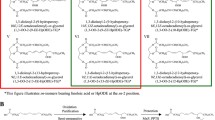Abstract
The ozonolysis of unsaturated lipids is a process that has been used to generate aldehydes, acids, alcohols, and other biobased chemical intermediates. Reported here is a method that can be used to measure the formation of nonanal and oleic acid during the ozonolysis of unsaturated vegetable oil fatty acids or their methyl esters to indicate the extent of the ozonolysis reaction. Derivatization was performed using boron trifluoride in methanol solution to transform nonanal and oleic acid into nonanal dimethyl acetal and oleic acid methyl ester, respectively. Undecanal and 10-heptadecenoic acid were used as internal standards and separation was performed using gas chromatography coupled with a flame ionization detector. The method was validated by performing a standard addition procedure in which nonanal or oleic acid standards were spiked into samples collected during the ozonolysis of oleic acid or canola oil fatty acid methyl ester (FAME). Linear regression results indicated that the measured nonanal and oleic acid are in good agreement with the actual amounts of nonanal and oleic acid added to the sample with at least 98 % recovery. The application of the method was demonstrated by the successful measurement of nonanal and oleic acid formed throughout the ozonolysis process for high oleic canola oil FAME.








Similar content being viewed by others
References
Gandini A (2008) Polymers from renewable resources: a challenge for the future of macromolecular materials. Macromolecules 41:9491–9504
Mohanty A, Misra M, Drzal L (2002) Sustainable bio-composites from renewable resources: opportunities and challenges in the green materials world. J Polym Environ 10:19–26
McGuire J, Haslam P, Bond G (2006) Ozonolysis in the production of chiral fine chemicals. In: Ager D (ed) Handbook of chiral chemicals. CRC, Taylor & Francis, Boca Raton, pp 164–185
Criegee R (1975) Mechanism of ozonolysis. Angew Chem Int Ed Engl 14:745–752
Bailey PS (1958) The reactions of ozone with organic compounds. Chem Rev 58:925–1010
Fliszar S, Carles J (1969) A quantitative investigation of ozonolysis reaction. VII. Ozonolyses of phenylethylenes in presence of oxygen-18-labeled benzaldehyde. J Am Chem Soc 91:2637–2643
Petrovic ZS, Zhang W, Javni I (2005) Structure and properties of polyurethanes prepared from triglyceride polyols by ozonolysis. Biomacromolecules 6:713–719
Narine SS, Kong X, Bouzidi L, Sporns P (2007) Physical properties of polyurethanes produced from polyols from seed oils: I. Elastomers. J Am Oil Chem Soc 84:55–63
Petrović ZS, Milić J, Xu Y, Cvetković I (2010) A chemical route to high molecular weight vegetable oil-based polyhydroxyalkanoate. Macromolecules 43:4120–4125
Sell CS (2014) Manufacture of fragrance ingredients. In: Chemistry and the sense of smell. Wiley, London, pp 296–356
Omonov TS, Kharraz E, Curtis JM (2011) Ozonolysis of canola oil: a study of product yields and ozonolysis kinetics in different solvent systems. J Am Oil Chem Soc 88:689–705
Dumont JM, Kharraz E, Qi H (2013) Production of polyols and mono-ols from 10 North American vegetable oils by ozonolysis and hydrogenation: a characterization study. Ind Crop Prod 49:830–836
Cvetkovic I, Milic J, Ionescu M, Petrovic ZS (2008) Preparation of 9-hydroxynonanoic acid methyl ester by ozonolysis of vegetable oils and its polycondensation. Hem Ind 62:319–328
Soriano NU Jr, Migo VP, Matsumura M (2003) Ozonation of sunflower oil: spectroscopic monitoring of the degree of unsaturation. J Am Oil Chem Soc 80:997–1001
Sadowska J, Johansson B, Johannessen E, Friman R, Broniarz-Press L, Rosenholm JB (2008) Characterization of ozonated vegetable oils by spectroscopic and chromatographic methods. Chem Phys Lipids 151:85–91
Acknowledgments
We acknowledge the University of Alberta Biorefining Conversion Network and Alberta Innovates Biosolutions for support for this research. Mr. Tavassoli-Kafrani thanks Alberta Innovates-Technology Futures for providing a scholarship.
Author information
Authors and Affiliations
Corresponding author
About this article
Cite this article
Tavassoli-Kafrani, M.H., Foley, P., Kharraz, E. et al. Quantification of Nonanal and Oleic Acid Formed During the Ozonolysis of Vegetable Oil Free Fatty Acids or Fatty Acid Methyl Esters. J Am Oil Chem Soc 93, 303–310 (2016). https://doi.org/10.1007/s11746-015-2780-7
Received:
Revised:
Accepted:
Published:
Issue Date:
DOI: https://doi.org/10.1007/s11746-015-2780-7




